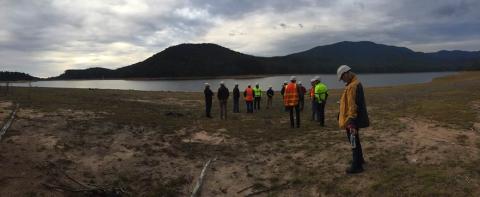
Fifteen catchment specialists looked out over the Maroondah Reservoir in the outskirts of Melbourne, animatedly exchanging experiences, ideas and challenges from around Australia and the US. And that was before the workshop was even underway.
You can never underestimate the value of bringing people together in the same room to solve problems. Especially when that problem is a “wicked” one – in this instance making a case for catchment management programs to be seen by regulators as an integral part of the drinking water supply chain.
At WSAA, I have seen that collaboration can bring great results and the saying of “stronger together than alone” starts to ring true. Last week really highlighted to me what makes a good collaborative research project and it was great to see all the experts in the room together. All eyes were firmly on our guest David Warne. David is the Assistant Commissioner at the NYC Department of Environment Protection. Despite having the responsibility to ensure safe drinking water supply to some nine million people in greater New York, he was a surprisingly calm and collected individual!
David had great insights from the New York experience and in particular, he spoke of the importance of community and NGO involvement in their catchment management programs. Many of their community engagement initiatives involve facilitating peer-to-peer interactions between neighbours who can recruit each other and exchange ideas from successful initiatives.
The US perspective also highlighted the importance of a strong regulatory framework, in the form of the Federal Clean Water Drinking Act, which helps underpin business cases for catchment management activities. Unfortunately we don’t have an equivalent strong regulatory framework here. But why do we care? Because it can be a barrier to approval of catchment management activities. That “wicked” problem again...
So, how do we measure success in catchment management programs? David Warne agreed with the Australian utilities that the provision of safe drinking water was the most important measure of success. But surely there was some value in the amenity of these beautiful catchments, and the communities and biodiversity they support? How do you measure this – and more importantly how do you convince the regulators to care?
This project is a great example of why we value our international research investments. Through the Water Research Foundation in the US, we not only received co-funding for this project but also an introduction to David, whose input proved invaluable. In 2014, WSAA and its members had a total of $1.6 million invested with our international research partners, for research valued at $11.8 million. Return on investment is often measured in leverage of funds – i.e. the bang for your buck – and this is an outstanding leverage of 13.6! Not to mention the multitude of networking and professional development opportunities that have been provided to members involved in these projects, something else we can’t put a value on but is equally important!
As the catchment managers continued their debate, my mind wandered to how we might measure the success of the project itself. Success for me would be producing a succinct product that's easy to use and doesn’t sit on a shelf collecting dust. I hope we can prove that collaborative research projects can be efficient, cost effective and practical. And that the participants will remember this workshop for years to come and will maintain this new network of peers to informally exchange knowledge and experiences.
What does research success look like to you?
